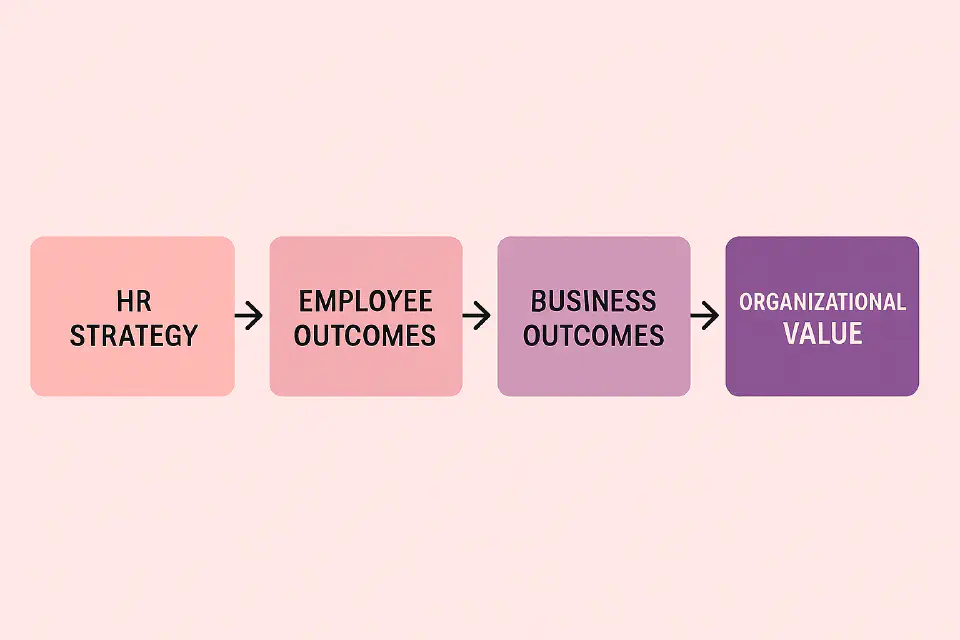
Linking HR Strategy to Organizational Value
A great HR strategy isn’t just about people—it’s about performance, growth, and value creation. Here's how to make the connection crystal clear.
Human Resource strategy doesn’t create value by existing on paper—it creates value when it’s executed in ways that align with business goals and produce measurable outcomes. For HR to be truly strategic, it must be able to demonstrate a clear link between its actions and the organization’s success.
Let’s explore what that looks like.
Why Linking HR to Value Matters
It’s easy for HR teams to fall into the trap of operational busyness—hiring, compliance, performance reviews—without ever tying those efforts to business performance. But leadership doesn’t invest in effort. It invests in impact.
That means HR must be able to answer tough questions:
- How does this initiative support our strategic goals?
- What’s the return on investment for this program?
- How does this people decision influence growth, margin, or risk?
The HR Value Chain
One of the most widely used frameworks to describe the link between HR activities and organizational outcomes is the HR Value Chain, introduced by HR scholar Luc Sels. It describes how HR practices influence value through a cascading model:
- HR Activities – Recruitment, L&D, performance management, etc.
- HR Outcomes – Employee skills, motivation, engagement
- Intermediate Outcomes – Productivity, innovation, quality of service
- Organizational Outcomes – Profitability, market share, growth
It’s not enough to do the work. HR needs to measure and communicate how that work drives value—often with data, business cases, and outcome-based reporting.
Identifying Value Levers in HR Strategy
Linking HR strategy to value starts with understanding which levers matter most in your organization. Some examples:
- In a tech company, the strategic lever might be engineering talent acquisition.
- In retail, it could be store-level employee engagement and turnover.
- In professional services, it might be leadership pipeline and billable hours.
Every organization has its own value chain, and HR’s job is to find where people practices intersect with business drivers.
From Strategy to Execution: Embedding Value in Action
A well-crafted HR strategy must translate into execution. This means:
- Designing programs that directly support business goals.
- Prioritizing high-impact areas (e.g. critical roles, key capabilities).
- Building internal partnerships (especially with Finance, Strategy, and Operations).
- Using KPIs that reflect value creation, not just activity.
Measuring HR’s Contribution to Value
This is often where things get fuzzy—but it doesn’t have to be. HR can adopt tools and metrics from finance and strategy disciplines, including:
- Human Capital ROI – Profit per dollar invested in employee programs
- People Analytics – Correlating HR data with business outcomes
- Balanced Scorecards – Tracking strategic contributions across functional areas
- Value Driver Trees – Modeling the cause-effect links from HR levers to business value
Data is not just for reporting—it’s a strategic tool for proving relevance and shaping decisions.
Communicating the Strategic Contribution of HR
Even when HR is delivering value, it may go unrecognized unless clearly articulated. This is why storytelling, dashboards, and strategic narratives matter.
What can help:
- Show before-and-after comparisons (e.g. retention, productivity)
- Use visuals (dashboards, heatmaps, journey maps)
- Translate HR results into business language (cost, risk, time, value)
Evolving Toward a Value-Centric HR Function
Strategic HR is no longer just about alignment. It’s about integration—embedding HR into the fabric of value creation.
That includes:
- Co-creating strategy with business leaders
- Allocating resources based on strategic value, not legacy programs
- Leading transformation efforts with people at the center
Conclusion
HR strategy becomes powerful when it’s visible, measurable, and indispensable to the business. That means going beyond alignment into true contribution—through clear value levers, strong metrics, execution discipline, and strategic storytelling.
Because when HR delivers value that the business can see, it earns a seat not just at the table—but at the core of strategy.